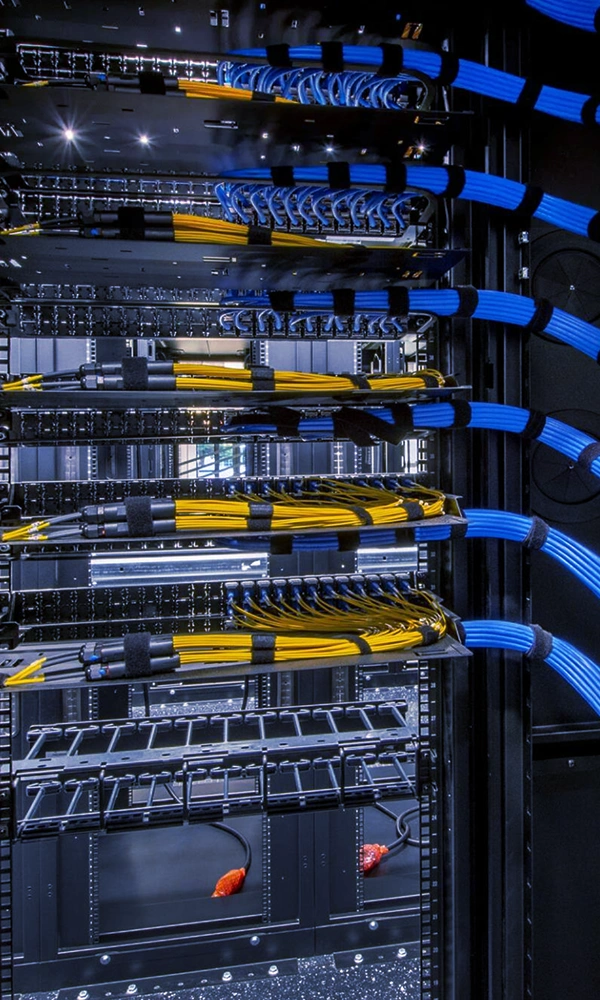DATACENTER SUPPORT AND NETWORKING
Managed Security Services (MSS)
- Rack PreparationBefore installing any equipment, datacenter racks or cabinets must be prepared to accommodate the hardware. This includes ensuring that the racks are properly grounded, securely anchored, and equipped with adequate power and cooling infrastructure.
- Equipment Selection and ConfigurationBased on the datacenter's requirements and specifications, IT equipment is selected and configured for installation. This may involve determining the optimal placement of servers, switches, storage arrays, and other devices within the rack to maximize space and airflow.
- Physical InstallationOnce the equipment is ready, it is physically installed within the racks or cabinets according to the predefined layout and configuration. This involves mounting the devices onto rack rails or shelves, securing them in place, and organizing the cabling for power and connectivity.
- Power and Connectivity SetupPower and network connections are established for each piece of equipment within the rack. Power cables are routed to power distribution units (PDUs) or power strips, while network cables are connected to switches or routers for network connectivity.
- Labeling and DocumentationTo ensure easy identification and maintenance, each installed device and its associated cables are labeled with clear and standardized labels. Additionally, detailed documentation is created, documenting the placement, configuration, and connections of all installed equipment.
- Testing and ValidationAfter installation, the functionality and performance of the installed equipment are tested to ensure proper operation. This may involve conducting power-on tests, verifying network connectivity, and running diagnostic checks to identify any issues or discrepancies.
- Documentation and Reporting• Comprehensive documentation is generated, documenting the rack and stack process, including equipment inventory, configurations, cable layouts, and test results.

Fiber Optic Cabling Installation and Termination
- Installation of fiber optic cables within the datacenter premises to facilitate high-speed data transmission.
- Termination of fiber optic cables, including fusion splicing or mechanical connectors, to ensure reliable connections between network devices.
Copper Cabling Installation and Termination
- Installation of copper cables, such as twisted pair cables (e.g., CAT 5e, CAT 6, CAT 6a) for Ethernet connectivity within the datacenter.
- Termination of copper cables using RJ45 connectors or other appropriate connectors for networking equipment and devices.
Structured Cabling System Design and Implementation
- Designing and implementing structured cabling systems that incorporate both fiber and copper cables to support datacenter networking requirements.
- Planning and organizing cable routes, cable trays, and patch panels for efficient cable management and connectivity.
Cable Patching and Patch Panel Installation
- Patching fiber and copper cables to networking equipment, servers, storage devices, and other infrastructure components using patch cords and patch panels.
- Installation of patch panels to facilitate easy connection and management of cables within the datacenter environment.
Cable Testing and Certification
- Testing and certifying fiber and copper cables to ensure compliance with industry standards and specifications for performance, bandwidth, and signal integrity.
- Conducting tests such as continuity testing, attenuation testing, and crosstalk testing to verify the quality and reliability of cable connections.
Cable Management and Labeling
- Implementing cable management solutions, including cable trays, cable management racks, and cable ties, to organize and secure fiber and copper cables.
- Labeling cables and patch panels with clear and standardized labeling schemes to facilitate easy identification and troubleshooting.
Fiber Optic Splicing and Fusion Splicing
- Performing fiber optic splicing and fusion splicing techniques to join optical fibers together seamlessly, ensuring low signal loss and high reliability in data transmission.
- Testing spliced fiber connections using optical time-domain reflectometers (OTDR) and other testing equipment to verify splice quality and performance.

